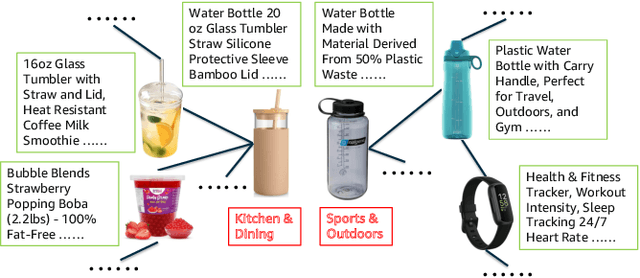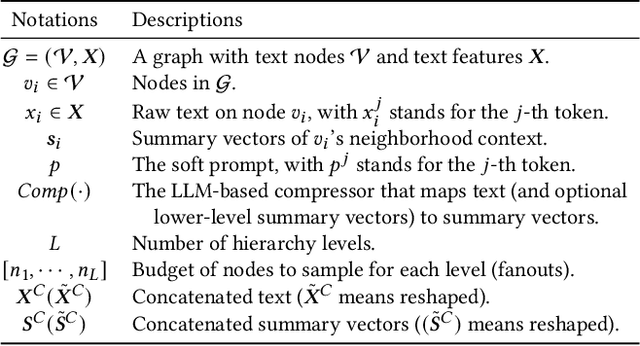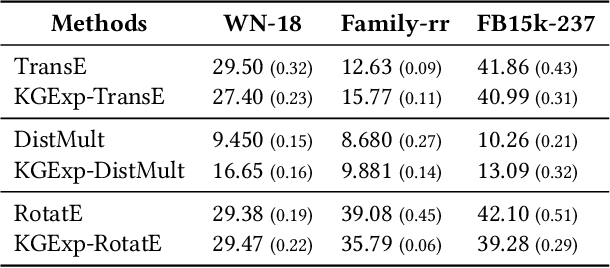Jiani Zhang
Towards Better Understanding Table Instruction Tuning: Decoupling the Effects from Data versus Models
Jan 24, 2025



Abstract:Recent advances in natural language processing have leveraged instruction tuning to enhance Large Language Models (LLMs) for table-related tasks. However, previous works train different base models with different training data, lacking an apples-to-apples comparison across the result table LLMs. To address this, we fine-tune base models from the Mistral, OLMo, and Phi families on existing public training datasets. Our replication achieves performance on par with or surpassing existing table LLMs, establishing new state-of-the-art performance on Hitab, a table question-answering dataset. More importantly, through systematic out-of-domain evaluation, we decouple the contributions of training data and the base model, providing insight into their individual impacts. In addition, we assess the effects of table-specific instruction tuning on general-purpose benchmarks, revealing trade-offs between specialization and generalization.
Hierarchical Compression of Text-Rich Graphs via Large Language Models
Jun 13, 2024



Abstract:Text-rich graphs, prevalent in data mining contexts like e-commerce and academic graphs, consist of nodes with textual features linked by various relations. Traditional graph machine learning models, such as Graph Neural Networks (GNNs), excel in encoding the graph structural information, but have limited capability in handling rich text on graph nodes. Large Language Models (LLMs), noted for their superior text understanding abilities, offer a solution for processing the text in graphs but face integration challenges due to their limitation for encoding graph structures and their computational complexities when dealing with extensive text in large neighborhoods of interconnected nodes. This paper introduces ``Hierarchical Compression'' (HiCom), a novel method to align the capabilities of LLMs with the structure of text-rich graphs. HiCom processes text in a node's neighborhood in a structured manner by organizing the extensive textual information into a more manageable hierarchy and compressing node text step by step. Therefore, HiCom not only preserves the contextual richness of the text but also addresses the computational challenges of LLMs, which presents an advancement in integrating the text processing power of LLMs with the structural complexities of text-rich graphs. Empirical results show that HiCom can outperform both GNNs and LLM backbones for node classification on e-commerce and citation graphs. HiCom is especially effective for nodes from a dense region in a graph, where it achieves a 3.48% average performance improvement on five datasets while being more efficient than LLM backbones.
FeatNavigator: Automatic Feature Augmentation on Tabular Data
Jun 13, 2024Abstract:Data-centric AI focuses on understanding and utilizing high-quality, relevant data in training machine learning (ML) models, thereby increasing the likelihood of producing accurate and useful results. Automatic feature augmentation, aiming to augment the initial base table with useful features from other tables, is critical in data preparation as it improves model performance, robustness, and generalizability. While recent works have investigated automatic feature augmentation, most of them have limited capabilities in utilizing all useful features as many of them are in candidate tables not directly joinable with the base table. Worse yet, with numerous join paths leading to these distant features, existing solutions fail to fully exploit them within a reasonable compute budget. We present FeatNavigator, an effective and efficient framework that explores and integrates high-quality features in relational tables for ML models. FeatNavigator evaluates a feature from two aspects: (1) the intrinsic value of a feature towards an ML task (i.e., feature importance) and (2) the efficacy of a join path connecting the feature to the base table (i.e., integration quality). FeatNavigator strategically selects a small set of available features and their corresponding join paths to train a feature importance estimation model and an integration quality prediction model. Furthermore, FeatNavigator's search algorithm exploits both estimated feature importance and integration quality to identify the optimized feature augmentation plan. Our experimental results show that FeatNavigator outperforms state-of-the-art solutions on five public datasets by up to 40.1% in ML model performance.
KGExplainer: Towards Exploring Connected Subgraph Explanations for Knowledge Graph Completion
Apr 05, 2024



Abstract:Knowledge graph completion (KGC) aims to alleviate the inherent incompleteness of knowledge graphs (KGs), which is a critical task for various applications, such as recommendations on the web. Although knowledge graph embedding (KGE) models have demonstrated superior predictive performance on KGC tasks, these models infer missing links in a black-box manner that lacks transparency and accountability, preventing researchers from developing accountable models. Existing KGE-based explanation methods focus on exploring key paths or isolated edges as explanations, which is information-less to reason target prediction. Additionally, the missing ground truth leads to these explanation methods being ineffective in quantitatively evaluating explored explanations. To overcome these limitations, we propose KGExplainer, a model-agnostic method that identifies connected subgraph explanations and distills an evaluator to assess them quantitatively. KGExplainer employs a perturbation-based greedy search algorithm to find key connected subgraphs as explanations within the local structure of target predictions. To evaluate the quality of the explored explanations, KGExplainer distills an evaluator from the target KGE model. By forwarding the explanations to the evaluator, our method can examine the fidelity of them. Extensive experiments on benchmark datasets demonstrate that KGExplainer yields promising improvement and achieves an optimal ratio of 83.3% in human evaluation.
Large Language Models(LLMs) on Tabular Data: Prediction, Generation, and Understanding -- A Survey
Mar 01, 2024Abstract:Recent breakthroughs in large language modeling have facilitated rigorous exploration of their application in diverse tasks related to tabular data modeling, such as prediction, tabular data synthesis, question answering, and table understanding. Each task presents unique challenges and opportunities. However, there is currently a lack of comprehensive review that summarizes and compares the key techniques, metrics, datasets, models, and optimization approaches in this research domain. This survey aims to address this gap by consolidating recent progress in these areas, offering a thorough survey and taxonomy of the datasets, metrics, and methodologies utilized. It identifies strengths, limitations, unexplored territories, and gaps in the existing literature, while providing some insights for future research directions in this vital and rapidly evolving field. It also provides relevant code and datasets references. Through this comprehensive review, we hope to provide interested readers with pertinent references and insightful perspectives, empowering them with the necessary tools and knowledge to effectively navigate and address the prevailing challenges in the field.
OpenTab: Advancing Large Language Models as Open-domain Table Reasoners
Feb 22, 2024



Abstract:Large Language Models (LLMs) trained on large volumes of data excel at various natural language tasks, but they cannot handle tasks requiring knowledge that has not been trained on previously. One solution is to use a retriever that fetches relevant information to expand LLM's knowledge scope. However, existing textual-oriented retrieval-based LLMs are not ideal on structured table data due to diversified data modalities and large table sizes. In this work, we propose OpenTab, an open-domain table reasoning framework powered by LLMs. Overall, OpenTab leverages table retriever to fetch relevant tables and then generates SQL programs to parse the retrieved tables efficiently. Utilizing the intermediate data derived from the SQL executions, it conducts grounded inference to produce accurate response. Extensive experimental evaluation shows that OpenTab significantly outperforms baselines in both open- and closed-domain settings, achieving up to 21.5% higher accuracy. We further run ablation studies to validate the efficacy of our proposed designs of the system.
Which Examples to Annotate for In-Context Learning? Towards Effective and Efficient Selection
Oct 30, 2023Abstract:Large Language Models (LLMs) can adapt to new tasks via in-context learning (ICL). ICL is efficient as it does not require any parameter updates to the trained LLM, but only few annotated examples as input for the LLM. In this work, we investigate an active learning approach for ICL, where there is a limited budget for annotating examples. We propose a model-adaptive optimization-free algorithm, termed AdaICL, which identifies examples that the model is uncertain about, and performs semantic diversity-based example selection. Diversity-based sampling improves overall effectiveness, while uncertainty sampling improves budget efficiency and helps the LLM learn new information. Moreover, AdaICL poses its sampling strategy as a Maximum Coverage problem, that dynamically adapts based on the model's feedback and can be approximately solved via greedy algorithms. Extensive experiments on nine datasets and seven LLMs show that AdaICL improves performance by 4.4% accuracy points over SOTA (7.7% relative improvement), is up to 3x more budget-efficient than performing annotations uniformly at random, while it outperforms SOTA with 2x fewer ICL examples.
NameGuess: Column Name Expansion for Tabular Data
Oct 19, 2023Abstract:Recent advances in large language models have revolutionized many sectors, including the database industry. One common challenge when dealing with large volumes of tabular data is the pervasive use of abbreviated column names, which can negatively impact performance on various data search, access, and understanding tasks. To address this issue, we introduce a new task, called NameGuess, to expand column names (used in database schema) as a natural language generation problem. We create a training dataset of 384K abbreviated-expanded column pairs using a new data fabrication method and a human-annotated evaluation benchmark that includes 9.2K examples from real-world tables. To tackle the complexities associated with polysemy and ambiguity in NameGuess, we enhance auto-regressive language models by conditioning on table content and column header names -- yielding a fine-tuned model (with 2.7B parameters) that matches human performance. Furthermore, we conduct a comprehensive analysis (on multiple LLMs) to validate the effectiveness of table content in NameGuess and identify promising future opportunities. Code has been made available at https://github.com/amazon-science/nameguess.
Mixed-Type Tabular Data Synthesis with Score-based Diffusion in Latent Space
Oct 14, 2023Abstract:Recent advances in tabular data generation have greatly enhanced synthetic data quality. However, extending diffusion models to tabular data is challenging due to the intricately varied distributions and a blend of data types of tabular data. This paper introduces TABSYN, a methodology that synthesizes tabular data by leveraging a diffusion model within a variational autoencoder (VAE) crafted latent space. The key advantages of the proposed TABSYN include (1) Generality: the ability to handle a broad spectrum of data types by converting them into a single unified space and explicitly capture inter-column relations; (2) Quality: optimizing the distribution of latent embeddings to enhance the subsequent training of diffusion models, which helps generate high-quality synthetic data, (3) Speed: much fewer number of reverse steps and faster synthesis speed than existing diffusion-based methods. Extensive experiments on six datasets with five metrics demonstrate that TABSYN outperforms existing methods. Specifically, it reduces the error rates by 86% and 67% for column-wise distribution and pair-wise column correlation estimations compared with the most competitive baselines.
PaGE-Link: Path-based Graph Neural Network Explanation for Heterogeneous Link Prediction
Mar 21, 2023Abstract:Transparency and accountability have become major concerns for black-box machine learning (ML) models. Proper explanations for the model behavior increase model transparency and help researchers develop more accountable models. Graph neural networks (GNN) have recently shown superior performance in many graph ML problems than traditional methods, and explaining them has attracted increased interest. However, GNN explanation for link prediction (LP) is lacking in the literature. LP is an essential GNN task and corresponds to web applications like recommendation and sponsored search on web. Given existing GNN explanation methods only address node/graph-level tasks, we propose Path-based GNN Explanation for heterogeneous Link prediction (PaGE-Link) that generates explanations with connection interpretability, enjoys model scalability, and handles graph heterogeneity. Qualitatively, PaGE-Link can generate explanations as paths connecting a node pair, which naturally captures connections between the two nodes and easily transfer to human-interpretable explanations. Quantitatively, explanations generated by PaGE-Link improve AUC for recommendation on citation and user-item graphs by 9 - 35% and are chosen as better by 78.79% of responses in human evaluation.
 Add to Chrome
Add to Chrome Add to Firefox
Add to Firefox Add to Edge
Add to Edge